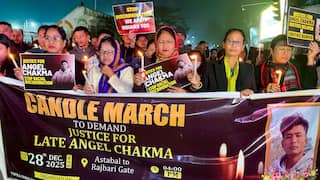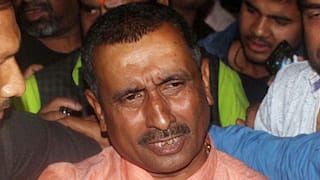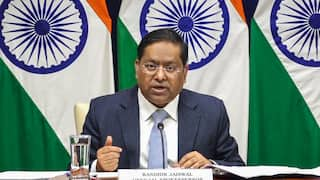Explorer
Women, Nonviolence, and Civil Resistance
The extraordinary courage and presence of mind that female students and indeed women from all walks of life have brought to the present demonstrations signify a more enhanced role for women in Indian public life and point to the strengths they bring in steering India towards a more democratic future.

Protestors offer roses to policemen during a demonstration against the Citizenship (Amendment) Act, at Mandi House, New Delhi.(FILE PIC/PTI)
One of the more remarkable features of the country-wide protests against the Citizenship Amendment Act (CAA) and the National Register of Citizens (NRC) surely has to be the fact that women have taken the lead in signaling their dissent against the heavy-handedness of the Indian state and the increasing encroachment upon constitutional liberties. Perhaps, in describing this as “remarkable”, I may be thought by some to be doing, if inadvertently, women a disservice in suggesting that they have not been prominent in previous civil disobedience movements. That is indubitably not the case: they were highly visible in the demonstrations that took place all over the country in the wake of the brutal sexual assault against “Nirbhaya”, just as they were in 2004 when twelve women, the Mothers of Manipur, stripped themselves naked in public to highlight the sexual violation of a young girl and, more generally, the ongoing and systemic problem of sexual violence against women.
The extraordinary courage and presence of mind that female students and indeed women from all walks of life have brought to the present demonstrations signify a more enhanced role for women in Indian public life and point to the strengths they bring in steering India towards a more democratic future. There is a widespread feeling that the agitation against the CAA (and the Citizenship Amendment Bill that preceded the act) and now the NRC caught the government unawares, but I would also hazard the argument that one of the many things that has rattled the government is the resistance, much of it wholly unexpected, put up by women. The statist view in India has never bothered to expend much thought on girls and women, except in its paternalistic role as conferring benefits on them as a form of “empowerment”, striving to have them retain the sacred aura of “Indian womanhood” and yet be emblematic of the “modern working woman”, and so on. There have been countless poster campaigns by successive Indian governments enjoining the citizenry to understand that to “honour women is to honour the nation”, urging people to “protect the girl child” and suggesting that in the “education of girls lies the salvation of the nation”.
Such slogans doubtless echo what both commonsense and justice dictate as true, but the present protests offer a more striking collage of images of women who have stepped outside the enforced cocoon of care and plunged into the muddy and wobbly waters of democratic dissent. Photographs of young female students offering roses to soldiers may appear a little cliched to those familiar with the global history of protest movements, but Indian women have been bold, inventive, resourceful, and disciplined in taking the lead, setting an example for men to follow, and incapacitating the state from taking decisive action. They have held the most interesting placards: “My dad thinks I am studying history. He doesn’t know that I am busy making one”, says one, while another says simply: “PM 2.0 is worse than PM 2.5.” PM 2.0 refers, of course, to Modi’s second term as Prime Minister; PM2.5 refers to atmospheric particulate matters, or fine particles which have a diameter of about 3% the diameter of a human hair and are thus invisible to the naked eye, and, moreover, once lodged in the lungs can induce chronic heart disease, respiratory problems, and death. More elaborate was the placard held by a young woman who marched from Mandi House to Jantar Mantar: Modi and Amit Shah sit around a bonfire, and Modi says: “It’s nice to have a little warmth in this cold weather, huh?” and Shah responds: “I’m so glad we started this fire.”
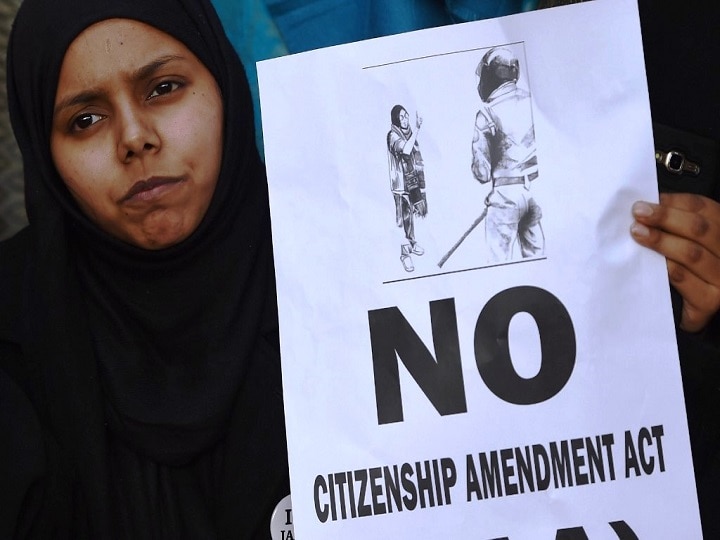 (A woman hold a placard at a protest outside Jamia Millia Islamia university over India’s new citizenship law in New Delhi on December 18, 2019. FILE PIC/AFP.)
But women’s protests have amounted to far more than all this: Indian women have shown the power of nonviolence. A little more than two weeks ago a video “went viral” and the civil resistance movement against CAA and NRC, which has now become part of the international news cycle, inserted itself into the global history of nonviolence. Demonstrations had been taken out by students at Jamia Millia Islamia; violence ensued, though the origins of that still remain somewhat uncertain. Three women students at Jamia—Aysha Renna, Labeeda Farzana, and Chanda Yadav—shielded a fellow male student from being beaten up by the police. They can be seen remonstrating with lathi-wielding policemen, coming between them and the male student, and reprimanding them for their unthinking brutality. In a very different demonstration, both of civil disobedience and an envious disregard for the respectability that comes from adhering to prescribed norms of social behavior, Rabeeha Abdurehim at Pondicherry University and Debasmita Chowdhury at Jadavpur University, both gold medalists at their respective institutions, expressed their firm opposition to CAA at commencement ceremonies. Ms. Chowdhury walked up to the dais, shouted “hum kagaaz nahin dikhayenge”, and then tore up the CAA in the presence of everyone before walking off the stage with a cry of “Inquilab Zindabad”.
The women of Shaheen Bagh, a predominantly Muslim neighborhood in Delhi’s Jamia Nagar, have been waging a silent demonstration against CAA and NRC for over two weeks. They have occupied a portion of the main highway connecting the city to NOIDA. Some women have not gone home for days, others are accompanied at the sit-in by their children. Those who are illiterate are nonetheless fully aware of what is at stake in the government plan to roll out a nation-wide NRC. They all understand that women are even more vulnerable: property papers are generally in the name of men, and many don’t have the required documents to prove Indian citizenship. Above all, their very presence, grit, and disciplined resistance gives the lie to the claim that the demonstrations have been fueled by “the opposition” or “outside instigators”. These women offer as decisive a repudiation as any that could be mustered of the specious claim that the demonstrations have been violent.
(A woman hold a placard at a protest outside Jamia Millia Islamia university over India’s new citizenship law in New Delhi on December 18, 2019. FILE PIC/AFP.)
But women’s protests have amounted to far more than all this: Indian women have shown the power of nonviolence. A little more than two weeks ago a video “went viral” and the civil resistance movement against CAA and NRC, which has now become part of the international news cycle, inserted itself into the global history of nonviolence. Demonstrations had been taken out by students at Jamia Millia Islamia; violence ensued, though the origins of that still remain somewhat uncertain. Three women students at Jamia—Aysha Renna, Labeeda Farzana, and Chanda Yadav—shielded a fellow male student from being beaten up by the police. They can be seen remonstrating with lathi-wielding policemen, coming between them and the male student, and reprimanding them for their unthinking brutality. In a very different demonstration, both of civil disobedience and an envious disregard for the respectability that comes from adhering to prescribed norms of social behavior, Rabeeha Abdurehim at Pondicherry University and Debasmita Chowdhury at Jadavpur University, both gold medalists at their respective institutions, expressed their firm opposition to CAA at commencement ceremonies. Ms. Chowdhury walked up to the dais, shouted “hum kagaaz nahin dikhayenge”, and then tore up the CAA in the presence of everyone before walking off the stage with a cry of “Inquilab Zindabad”.
The women of Shaheen Bagh, a predominantly Muslim neighborhood in Delhi’s Jamia Nagar, have been waging a silent demonstration against CAA and NRC for over two weeks. They have occupied a portion of the main highway connecting the city to NOIDA. Some women have not gone home for days, others are accompanied at the sit-in by their children. Those who are illiterate are nonetheless fully aware of what is at stake in the government plan to roll out a nation-wide NRC. They all understand that women are even more vulnerable: property papers are generally in the name of men, and many don’t have the required documents to prove Indian citizenship. Above all, their very presence, grit, and disciplined resistance gives the lie to the claim that the demonstrations have been fueled by “the opposition” or “outside instigators”. These women offer as decisive a repudiation as any that could be mustered of the specious claim that the demonstrations have been violent.
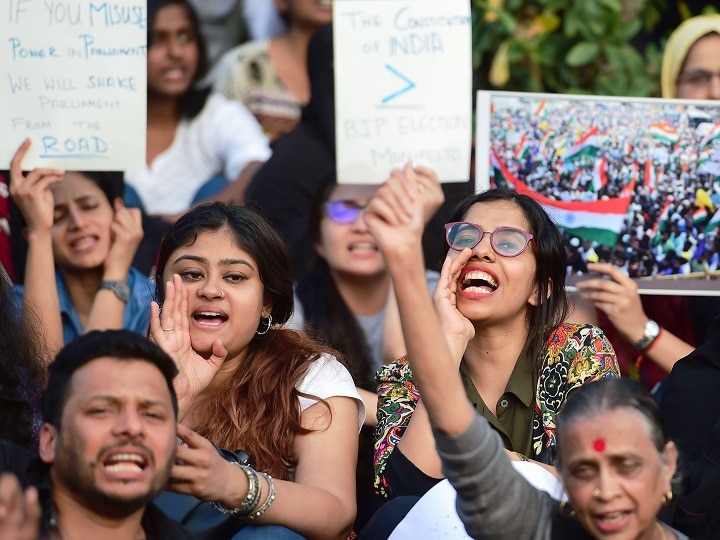 (Bengaluru: Protestors display placards and raise slogans during a protest against the Citizenship Amendment Act-CAA, National Register of Citizenship (NRC) and National Population Register(NPR) in Bengaluru, Saturday, Dec. 28, 2019. PTI Photo)
That women have been at the helm of a nonviolent affirmation of the constitutional promise of equality under the law and nonviolent resistance to state thuggery would have come as no surprise to Mohandas Gandhi. He had been a keen observer of the suffragette moment in Britain and as early as 1907 wrote a piece in Gujarati, “Brave Women”, in their defense. Women were, in his view, naturally predisposed towards nonviolence—though, as he pointed out repeatedly, it was necessary to make a distinction between “nonviolence of the weak” and “nonviolence of the strong”. By “weak” he meant to designate not women as such, but rather those, whether men or women, who turned to nonviolence not from choice, deliberation, or moral reasoning but from dint of habit, instinct, or, most importantly, circumstances. Women, Gandhi was convinced, could be the ideal satyagrahis, if their natural disposition towards nonviolence could be turned to generate a disciplined and systematic movement of nonviolent social transformation.
Writing in the pages of his weekly Harijan over the years, Gandhi made known his view that “woman is the incarnation of ahimsa. Ahimsa means infinite love, which again means infinite capacity for suffering.” Love and suffering are perhaps not the keywords of our times as much as are “equality” and “rights” in the discourse of nonviolence. But, whatever language strikes one as the most apposite, the emergence of women in the present civil resistance movement is doubtless the most promising sign that the country has not yet surrendered to the tone-deaf authoritarianism of a state that is drunk on its own victories. Women, now as many times in the past, will surely demonstrate that the democratic spirit is incompatible with naked muscularity.
(Vinay Lal is a writer, blogger, cultural critic, and Professor of History at UCLA)
Disclaimer: The opinions, beliefs and views expressed by the various authors and forum participants on this website are personal and do not reflect the opinions, beliefs and views of ABP News Network Pvt Ltd.
(Bengaluru: Protestors display placards and raise slogans during a protest against the Citizenship Amendment Act-CAA, National Register of Citizenship (NRC) and National Population Register(NPR) in Bengaluru, Saturday, Dec. 28, 2019. PTI Photo)
That women have been at the helm of a nonviolent affirmation of the constitutional promise of equality under the law and nonviolent resistance to state thuggery would have come as no surprise to Mohandas Gandhi. He had been a keen observer of the suffragette moment in Britain and as early as 1907 wrote a piece in Gujarati, “Brave Women”, in their defense. Women were, in his view, naturally predisposed towards nonviolence—though, as he pointed out repeatedly, it was necessary to make a distinction between “nonviolence of the weak” and “nonviolence of the strong”. By “weak” he meant to designate not women as such, but rather those, whether men or women, who turned to nonviolence not from choice, deliberation, or moral reasoning but from dint of habit, instinct, or, most importantly, circumstances. Women, Gandhi was convinced, could be the ideal satyagrahis, if their natural disposition towards nonviolence could be turned to generate a disciplined and systematic movement of nonviolent social transformation.
Writing in the pages of his weekly Harijan over the years, Gandhi made known his view that “woman is the incarnation of ahimsa. Ahimsa means infinite love, which again means infinite capacity for suffering.” Love and suffering are perhaps not the keywords of our times as much as are “equality” and “rights” in the discourse of nonviolence. But, whatever language strikes one as the most apposite, the emergence of women in the present civil resistance movement is doubtless the most promising sign that the country has not yet surrendered to the tone-deaf authoritarianism of a state that is drunk on its own victories. Women, now as many times in the past, will surely demonstrate that the democratic spirit is incompatible with naked muscularity.
(Vinay Lal is a writer, blogger, cultural critic, and Professor of History at UCLA)
Disclaimer: The opinions, beliefs and views expressed by the various authors and forum participants on this website are personal and do not reflect the opinions, beliefs and views of ABP News Network Pvt Ltd.
 (A woman hold a placard at a protest outside Jamia Millia Islamia university over India’s new citizenship law in New Delhi on December 18, 2019. FILE PIC/AFP.)
But women’s protests have amounted to far more than all this: Indian women have shown the power of nonviolence. A little more than two weeks ago a video “went viral” and the civil resistance movement against CAA and NRC, which has now become part of the international news cycle, inserted itself into the global history of nonviolence. Demonstrations had been taken out by students at Jamia Millia Islamia; violence ensued, though the origins of that still remain somewhat uncertain. Three women students at Jamia—Aysha Renna, Labeeda Farzana, and Chanda Yadav—shielded a fellow male student from being beaten up by the police. They can be seen remonstrating with lathi-wielding policemen, coming between them and the male student, and reprimanding them for their unthinking brutality. In a very different demonstration, both of civil disobedience and an envious disregard for the respectability that comes from adhering to prescribed norms of social behavior, Rabeeha Abdurehim at Pondicherry University and Debasmita Chowdhury at Jadavpur University, both gold medalists at their respective institutions, expressed their firm opposition to CAA at commencement ceremonies. Ms. Chowdhury walked up to the dais, shouted “hum kagaaz nahin dikhayenge”, and then tore up the CAA in the presence of everyone before walking off the stage with a cry of “Inquilab Zindabad”.
The women of Shaheen Bagh, a predominantly Muslim neighborhood in Delhi’s Jamia Nagar, have been waging a silent demonstration against CAA and NRC for over two weeks. They have occupied a portion of the main highway connecting the city to NOIDA. Some women have not gone home for days, others are accompanied at the sit-in by their children. Those who are illiterate are nonetheless fully aware of what is at stake in the government plan to roll out a nation-wide NRC. They all understand that women are even more vulnerable: property papers are generally in the name of men, and many don’t have the required documents to prove Indian citizenship. Above all, their very presence, grit, and disciplined resistance gives the lie to the claim that the demonstrations have been fueled by “the opposition” or “outside instigators”. These women offer as decisive a repudiation as any that could be mustered of the specious claim that the demonstrations have been violent.
(A woman hold a placard at a protest outside Jamia Millia Islamia university over India’s new citizenship law in New Delhi on December 18, 2019. FILE PIC/AFP.)
But women’s protests have amounted to far more than all this: Indian women have shown the power of nonviolence. A little more than two weeks ago a video “went viral” and the civil resistance movement against CAA and NRC, which has now become part of the international news cycle, inserted itself into the global history of nonviolence. Demonstrations had been taken out by students at Jamia Millia Islamia; violence ensued, though the origins of that still remain somewhat uncertain. Three women students at Jamia—Aysha Renna, Labeeda Farzana, and Chanda Yadav—shielded a fellow male student from being beaten up by the police. They can be seen remonstrating with lathi-wielding policemen, coming between them and the male student, and reprimanding them for their unthinking brutality. In a very different demonstration, both of civil disobedience and an envious disregard for the respectability that comes from adhering to prescribed norms of social behavior, Rabeeha Abdurehim at Pondicherry University and Debasmita Chowdhury at Jadavpur University, both gold medalists at their respective institutions, expressed their firm opposition to CAA at commencement ceremonies. Ms. Chowdhury walked up to the dais, shouted “hum kagaaz nahin dikhayenge”, and then tore up the CAA in the presence of everyone before walking off the stage with a cry of “Inquilab Zindabad”.
The women of Shaheen Bagh, a predominantly Muslim neighborhood in Delhi’s Jamia Nagar, have been waging a silent demonstration against CAA and NRC for over two weeks. They have occupied a portion of the main highway connecting the city to NOIDA. Some women have not gone home for days, others are accompanied at the sit-in by their children. Those who are illiterate are nonetheless fully aware of what is at stake in the government plan to roll out a nation-wide NRC. They all understand that women are even more vulnerable: property papers are generally in the name of men, and many don’t have the required documents to prove Indian citizenship. Above all, their very presence, grit, and disciplined resistance gives the lie to the claim that the demonstrations have been fueled by “the opposition” or “outside instigators”. These women offer as decisive a repudiation as any that could be mustered of the specious claim that the demonstrations have been violent.
 (Bengaluru: Protestors display placards and raise slogans during a protest against the Citizenship Amendment Act-CAA, National Register of Citizenship (NRC) and National Population Register(NPR) in Bengaluru, Saturday, Dec. 28, 2019. PTI Photo)
That women have been at the helm of a nonviolent affirmation of the constitutional promise of equality under the law and nonviolent resistance to state thuggery would have come as no surprise to Mohandas Gandhi. He had been a keen observer of the suffragette moment in Britain and as early as 1907 wrote a piece in Gujarati, “Brave Women”, in their defense. Women were, in his view, naturally predisposed towards nonviolence—though, as he pointed out repeatedly, it was necessary to make a distinction between “nonviolence of the weak” and “nonviolence of the strong”. By “weak” he meant to designate not women as such, but rather those, whether men or women, who turned to nonviolence not from choice, deliberation, or moral reasoning but from dint of habit, instinct, or, most importantly, circumstances. Women, Gandhi was convinced, could be the ideal satyagrahis, if their natural disposition towards nonviolence could be turned to generate a disciplined and systematic movement of nonviolent social transformation.
Writing in the pages of his weekly Harijan over the years, Gandhi made known his view that “woman is the incarnation of ahimsa. Ahimsa means infinite love, which again means infinite capacity for suffering.” Love and suffering are perhaps not the keywords of our times as much as are “equality” and “rights” in the discourse of nonviolence. But, whatever language strikes one as the most apposite, the emergence of women in the present civil resistance movement is doubtless the most promising sign that the country has not yet surrendered to the tone-deaf authoritarianism of a state that is drunk on its own victories. Women, now as many times in the past, will surely demonstrate that the democratic spirit is incompatible with naked muscularity.
(Vinay Lal is a writer, blogger, cultural critic, and Professor of History at UCLA)
Disclaimer: The opinions, beliefs and views expressed by the various authors and forum participants on this website are personal and do not reflect the opinions, beliefs and views of ABP News Network Pvt Ltd.
(Bengaluru: Protestors display placards and raise slogans during a protest against the Citizenship Amendment Act-CAA, National Register of Citizenship (NRC) and National Population Register(NPR) in Bengaluru, Saturday, Dec. 28, 2019. PTI Photo)
That women have been at the helm of a nonviolent affirmation of the constitutional promise of equality under the law and nonviolent resistance to state thuggery would have come as no surprise to Mohandas Gandhi. He had been a keen observer of the suffragette moment in Britain and as early as 1907 wrote a piece in Gujarati, “Brave Women”, in their defense. Women were, in his view, naturally predisposed towards nonviolence—though, as he pointed out repeatedly, it was necessary to make a distinction between “nonviolence of the weak” and “nonviolence of the strong”. By “weak” he meant to designate not women as such, but rather those, whether men or women, who turned to nonviolence not from choice, deliberation, or moral reasoning but from dint of habit, instinct, or, most importantly, circumstances. Women, Gandhi was convinced, could be the ideal satyagrahis, if their natural disposition towards nonviolence could be turned to generate a disciplined and systematic movement of nonviolent social transformation.
Writing in the pages of his weekly Harijan over the years, Gandhi made known his view that “woman is the incarnation of ahimsa. Ahimsa means infinite love, which again means infinite capacity for suffering.” Love and suffering are perhaps not the keywords of our times as much as are “equality” and “rights” in the discourse of nonviolence. But, whatever language strikes one as the most apposite, the emergence of women in the present civil resistance movement is doubtless the most promising sign that the country has not yet surrendered to the tone-deaf authoritarianism of a state that is drunk on its own victories. Women, now as many times in the past, will surely demonstrate that the democratic spirit is incompatible with naked muscularity.
(Vinay Lal is a writer, blogger, cultural critic, and Professor of History at UCLA)
Disclaimer: The opinions, beliefs and views expressed by the various authors and forum participants on this website are personal and do not reflect the opinions, beliefs and views of ABP News Network Pvt Ltd.
Follow Blog News on ABP Live for more latest stories and trending topics. Watch breaking news and top headlines online on ABP News LIVE TV
View More
















